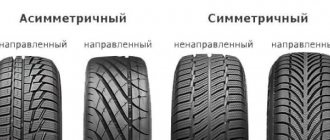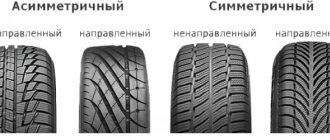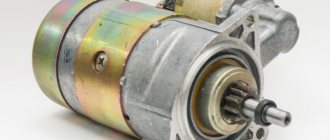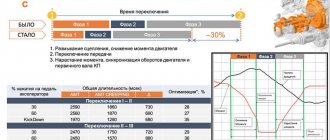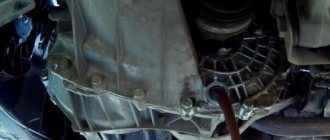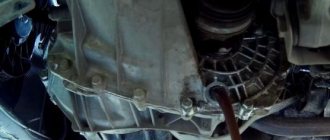Robot or CVT
Which is better, a robot or a variator on the Vesta - you can answer this question by studying the reviews of the owners. Drivers who were able to compare both types of transmissions share their impressions on websites dedicated to domestic cars.
Start of movement
In the latest releases of Lada Vesta with AMT, the designers have provided a “crawling” mode. When the brake pedal was released, the car began to move slowly at idle speed. This feature causes complaints from drivers. There is a delay, acceleration is uneven, twitching is felt. After some time, the speed increases, and in city traffic jams you have to slow down.
On a slippery road. Photo source: ac-ladaufa.ru
Against the background of such robot actions, the variator has an advantage. Acceleration is smooth, no jolts or twitches. Rolling and climbing are similar to a full-fledged automatic transmission. When parking, the car behaves more confidently.
Noisiness
The noise in the cabin of a car with a robotic gearbox is stronger than with a CVT. The hum in the AMT becomes audible even at low speeds. When picking up speed, the advantage of the variator is more obvious.
Vibration
An engine equipped with an AMT vibrates noticeably more than a power unit with a CVT. When compared with an automatic transmission, you get the feeling that a car with a robotic gearbox has a “floating” speed.
Gaining speed and dynamics
Vesta with a robotic gearbox picks up speed better than with a CVT only when engaging third gear. The first two are short, the driver does not have time to feel the acceleration. On the fourth, the advantage with the CVT is noticeable. Plus AMT is a direct connection between the gas pedal and the engine. However, the number of gears is small and switching takes a long time.
Vesta automatic. Photo source: va-online.ru
The CVT has a long response to pressing the gas pedal, and acceleration is slow. After gaining speed, the car becomes more dynamic, and traction failures are not felt. Acceleration after 80 km/h is significantly better than that of the robot; the advantage is felt when overtaking on the highway.
Fuel consumption
Vesta with a CVT is more economical than with a robotic gearbox. The average fuel consumption of the AMT is higher, the difference is 2 liters per 100 kilometers. With gasoline prices constantly rising, this is an advantage of the CVT, even at its higher price.
Many owners who took a test drive made a positive decision whether to buy a Lada Vesta with a CVT.
CVT on Lada Vesta
Some buyers do not know what kind of variator they put on the Vesta. The new modification of the car received a continuously variable variator in the Vesta Jatco JF015E.
CVT Jatco JF015E. Photo source: akppwiki.ru
Paired with this transmission option, the car is equipped with a 1.6-liter engine with a power of 113 l/s. This power unit is installed on alliance models such as Arcana, Captur, Logan, Sandero. Factory engine classification is H4M.
The variator can be installed on all Vesta models, except for the basic version. When choosing a Jatco JF015E box, the buyer does not need to pay for additional functions. This distinguishes the Vesta AT modification from its competitors.
Lada Vesta automatic
This transmission is considered a new product from the AvtoVAZ plant, but the platform for its development was the good old gearbox with index number 2180, which was originally mechanical. The gear shift system of this transmission is controlled by two electromechanical actuators, which are controlled by the TCU (terminal adapter control unit). The gear shift actuator is conveniently located in the place where the cable shift mechanism once was.
The creation of this transmission and its installation on the Lada Vesta car is determined solely by the pricing policy of the plant. The fact is that installing a full-fledged automatic transmission on a given car could significantly increase its cost, which in turn could scare away potential buyers.
Even before the production version of the Lada Vesta went on sale, controversy arose around it - whether the new models would have an automatic transmission. When the technical characteristics of the car were clarified by the manufacturer, it turned out that it received two transmission options - but there was no automatic among them.
Only the usual “mechanics” and robotic gearbox (AMT), which has already been used on the Priora and Granta models. The first owners of Vesta with a “robot” have already had the opportunity to test and evaluate the transmission - but their reviews turned out to be mixed, which, of course, is due to the presence Such a transmission has both pros and cons.
The basic option for the development of the Lada Vesta robotic gearbox was the model developed by the car manufacturer - the domestic concern AvtoVAZ.
Although, for example, the designers borrowed the concept of “mechanics” for VAZ from Renault.
The AMT lever on Vesta does not have a parking position. Only reverse and neutral gears, “drive” (automatic mode) and switching to manual control are available. In manual mode, you can only drive forward. Neutral and reverse are missing - although to use them you just need to transfer control to the car electronics.
Of course, not all motorists have a positive attitude towards cars with a robotic transmission.
Transmission Jatco JF015E
The Jatco company, part of the Nissan group, released a new CVT model in 2010, which received the full designation Jatco JF015E. Before installing this box on AvtoVAZ cars, engineers improved and finalized the transmission.
Device
The V-belt mechanism is the main part of the box. The elements of the device are cone pulleys and a pushing belt, which transmits torque that changes as the pulleys move closer and further apart. The box also includes a hydraulic unit and a two-stage planetary gearbox, which reduces the weight of the structure and increases the range of gear ratios.
Resource Jatco JF015E
The use of planetary gears in transmissions for small-volume engines makes the design smaller and more compact, but impairs reliability and reduces the overall service life of the unit. The planned service life of the transmissions is 120 thousand kilometers. In practice, box failure occurs earlier. Repair requires special equipment and skilled technicians.
Positive sides
The modified version of the new transmission has advantages:
- the variator has become more compact, it is better located in the perimeter of the subframe, due to which the ground clearance has decreased;
- the load mode is lightened when switching from forward to reverse gear, they shift clearly and smoothly;
- the load when mixing transmission oil has decreased, which is important at low temperatures;
- The functioning of the box cooling system has been improved, it is brought into the same circuit with the engine;
- the acceleration of the car is smooth, without jerks or dips in traction.
Vesta with automatic transmission. Photo source: news.myseldon.com
The developers of the modified Jatco JF015E transmission assure that oil is filled for the entire service life of the automatic transmission. Replacement will only be required during repairs. Although in fact it is better to change it after 100 thousand km, which can significantly increase the service life of the box. But this needs to be done in a workshop.
Minuses
The operating instructions indicate the disadvantages of a CVT transmission that the car driver should pay attention to:
- manufacturers do not recommend sudden starts, slipping and sudden braking - these factors lead to premature wear of the transmission;
- It is prohibited to tow the car for an emergency engine start;
- It is not recommended to use a trailer, as this increases the load on the variator.
Following the instructions, you must treat the variator with care and avoid an aggressive driving style. By following the recommendations, you can avoid the costs of premature box repairs.
CVT problems
Cars with a CVT arrived at dealers in November 2021. Since the summer, the Jatco gearbox has been installed on the XRAY Cross, during which time the operation of the cars revealed problems with the transmission.
Oil quality
The transmission is demanding on the quality of ATF fluid. If you use oil of a class lower than NS-3, recommended by the manufacturer, the variator valve body may fail.
At every vehicle maintenance, it is recommended to check the condition of the lubricant in the box.
Bearing failure
Before the modernization, there were many complaints about the adjustment of the input shaft roller bearing during assembly. The axial play gap was set incorrectly. When pinched, the hub was destroyed, which led to failure of the entire gearbox. Engineers corrected the defect, the unit became reliable, but repairs require fine tuning.
Sun gear failure
This structural element cannot withstand maximum loads and becomes unusable. The gear is welded from two parts; when the car is working hard, the seam does not hold up, the part breaks, and the entire assembly fails. A symptom of a breakdown is the absence of reverse gear when the corresponding position of the shift knob is turned on. Another sign is that the car does not move forward.
Oil pump failure
The valve in this unit fails; it hangs due to oil contaminated with wear products. The lubricant pressure in the variator drops. As a result, the driver feels jolts or jerks when moving from a standstill.
Operating rules
The driver is informed in the operating instructions about how the variator works on the Vesta. The control knob has the following switches:
- P – parking;
- R – back;
- N – neutral position;
- D – forward;
- M “+” and “–” – manual switching of a lower or higher gear.
Control knob on Vesta. Photo source: akppwiki.ru
The engine is started in position P. The brake pedal is pressed, and when the lock button is pressed, the handle is moved to D or R, depending on where the movement will be directed.
The gear shift lines are indicated on the handle:
- From P to neutral position N, forward – D, backward – R.
- In manual mode M, downshifts or upshifts are selected.
Mode M is activated only when moving from position D. You can move in reverse only by moving the handle to R from N. The engaged gear is displayed on the dashboard screen.
The rules prohibit moving the lever to the parking position P while driving. This action can lead to damage to the gearbox. When stopping briefly at a traffic light or in another similar situation, P and N are not activated and the vehicle is held down with the brake pedal.
To extend the service life of the transmission and avoid costly repairs, you should follow the rules prescribed in the instructions:
- before starting to drive, especially in winter, let the engine idle for a few minutes;
- immediately after starting to move, rapid acceleration is not recommended;
- the driver must avoid slipping, sudden starts and sudden braking;
- It is prohibited to tow the vehicle to start the engine.
Until the vehicle reaches a mileage of 2 thousand kilometers, towing other vehicles and trailers is prohibited.
Instructions for using a machine with AMT
How to use the new gearbox? Reviews from owners of the Lada Vesta 1.8 robot indicate that you still need to learn how to use the AMT. The car's on-board computer displays information that helps monitor the operation of the transmission:
- Mode (manual/automatic).
- Active transmission.
- Brake pedal activity.
So how do you start a Lada Vesta with AMT? To do this you need to follow a number of simple steps:
- Press the brake pedal.
- Move the shift lever to the neutral position.
- Start the car.
It is important to note that any changes in the position of the selector can only be made while the brake pedal is pressed. If you want to park the car, the manufacturer recommends turning off the engine, leaving the handle in the manual or automatic mode position. Very often, novice drivers have a question: what to do if you get stuck in a traffic jam on a slope? To prevent the car from rolling back, it is permissible to lightly press the gas pedal. When driving on a slope, the robot selects first or second gear so that the engine does not stall.
Another useful feature of LADA with AMT is that it can be started from a pusher. Rope launch is activated at speeds of 7 km/h and above. The car also has a transmission brake function. When rolling down an inclined surface, it is permissible to use the brake pedal for more effective braking. All these useful modes make operating the Lada Vesta with AMT convenient and comfortable.
Possibility of replacing the CVT with a manual transmission
When using Vesta with a CVT, some owners have problems with the convenience of driving the car. In this situation, the question arises: is it possible to replace the gearbox with a manual transmission?
If the variator breaks down, repairing it or purchasing a new Jatco JF015E transmission will require significant financial costs. The cost of a new variator is 185 thousand rubles, a new manual transmission is 50. In this case, replacing it with a manual transmission seems more economical.
Replacing a CVT is an expensive proposition. Photo source: drive2.ru
On websites dedicated to AvtoVAZ cars, this issue has been repeatedly raised on forums. After analyzing articles, reviews, and user messages, we can come to the conclusion that replacing a CVT with a manual transmission is possible. However, there are opinions that prove the inappropriateness of this work:
- The manual transmission and the cost of replacing the transmission can be comparable to the price of a new CVT with installation;
- Abnormal modifications can significantly degrade the performance of the vehicle's electronic system.
The most reasonable way out of the situation is to sell the Vesta with a repaired variator and purchase a car with a manual transmission.
Automatic expected
Many people are concerned about the issue of the machine gun. The predecessors Kalina and Grant already had a four-speed Jatco automatic, why isn’t it on the 2180? The fact is that there is no suitable base for the machine gun on the Lada Vesta. The mentioned box is already outdated, and purchasing a new one will significantly increase the price of the car, which is contrary to the policy of the Volga Automobile Plant.
Company President Nicolas More denied rumors about a 4-band automatic transmission for the most popular Lada models. So will the Lada Vesta have a gun? Most likely Yes. It will be a 6-speed modern transmission. Negotiations are already underway on the creation of a new plant in the Russian Federation; automatic transmissions will be created at the plant with the support of foreign companies. The appearance of an automatic machine on the Lada Vesta should be expected in at least 4-6 years.



